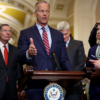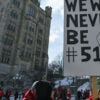Popular opinion demonizes the U.S. for importing more goods than it exports, or running a “trade deficit.” This view maintains that the trade deficit is costing jobs and slowing economic growth. “The $600 billion annual deficit is the most significant barrier to achieving a robust economic recovery and creating jobs,” charges a recent column. Yet this popular understanding, which is based on an incomplete assessment of the trade equation, is wrong.
The prevailing view assumes that exchangingU.S.currency for foreign goods leaks money out of circulation. The reason for this confusion is that gross domestic product (GDP)—the total value of everything produced in the U.S.—is determined by removing imports from the final calculation. This is merely because imports aren’t produced within theU.S., but it does not mean that money exchanged for imported goods drops out of the economy.
Money channeled abroad must circulate back to the U.S.economy. If the dollars are not quickly spent on U.S. goods and services, they are invested in U.S. assets such as Treasuries, corporate bonds and stocks, and bank deposits. The balance of payments balances. As Heritage’s Bryan Riley reports, in 2011, the “overall U.S. international transactions deficit was $0. That means the number of dollars leaving the country and the number of dollars entering the country in 2011 balance out.”
The Daily Signal depends on the support of readers like you. Donate now
Furthermore, far from hollowing out economic growth, trade gives Americans purchasing power, as the cheapest goods are available to them. More income is left for other investments and purchases as a result. Besides, money sent abroad that is invested back into theU.S.improves our productive capacity. It’s a win-win for growth.
The proof: “Since 1980, real U.S. GDP has grown at an annualized rate of 3.6 percent during those periods of rising trade deficits, compared to a sluggish 1.0 percent during periods of shrinking deficits,” according to the Cato Institute.
The words “trade deficit” may carry a negative connotation, which is what many politicians and talking heads would like us to believe. Slicing through the talking points and unearthing the full economic picture shows this view is too narrow-minded.




























